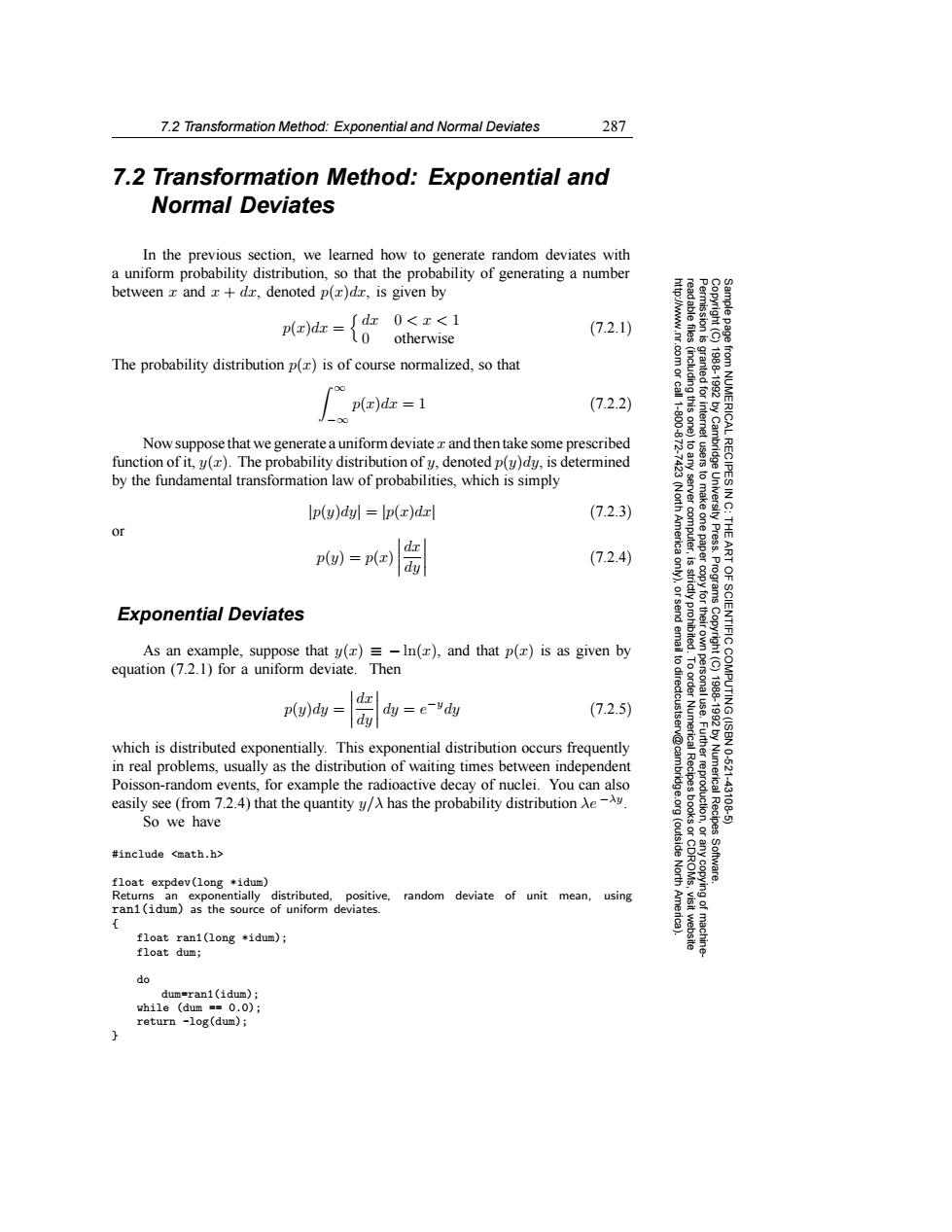正在加载图片...

7.2 Transformation Method:Exponential and Normal Deviates 287 7.2 Transformation Method:Exponential and Normal Deviates In the previous section,we learned how to generate random deviates with a uniform probability distribution,so that the probability of generating a number between x and x+dr,denoted p(x)dr,is given by p(x)dx ∫dx0<x<1 10 (7.2.1) otherwise The probability distribution p()is of course normalized,so that g p(x)dx =1 (7.2.2) 喜入含 Now suppose that we generate a uniform deviate x and then take some prescribed function of it,y().The probability distribution of y,denoted p(y)dy,is determined by the fundamental transformation law of probabilities,which is simply 2 p(y)dyl=p(x)dx (7.2.3) or dx Press. p(y)=p(x) d西 (7.2.4) 9 Exponential Deviates IENTIFIC As an example,suppose that y()=-In(),and that p()is as given by equation (7.2.1)for a uniform deviate.Then 6 dx p(y)dy= dy e-vdy dy (7.2.5) COMPUTING (ISBN 188810920 which is distributed exponentially.This exponential distribution occurs frequently in real problems,usually as the distribution of waiting times between independent Poisson-random events,for example the radioactive decay of nuclei.You can also easily see(from 7.2.4)that the quantity y/A has the probability distribution Ae-A. uurrggroglrion Numerical Recipes 10-521 4310-5 So we have #include <math.h> (outside North Software. float expdev(long *idum) Returns an exponentially distributed,positive,random deviate of unit mean, using ran1(idum)as the source of uniform deviates. Ame float ran1(long *idum); float dum; do dum=ran1(idun); while (dum ==0.0); return -log(dum);7.2 Transformation Method: Exponential and Normal Deviates 287 Permission is granted for internet users to make one paper copy for their own personal use. Further reproduction, or any copyin Copyright (C) 1988-1992 by Cambridge University Press. Programs Copyright (C) 1988-1992 by Numerical Recipes Software. Sample page from NUMERICAL RECIPES IN C: THE ART OF SCIENTIFIC COMPUTING (ISBN 0-521-43108-5) g of machinereadable files (including this one) to any server computer, is strictly prohibited. To order Numerical Recipes books or CDROMs, visit website http://www.nr.com or call 1-800-872-7423 (North America only), or send email to directcustserv@cambridge.org (outside North America). 7.2 Transformation Method: Exponential and Normal Deviates In the previous section, we learned how to generate random deviates with a uniform probability distribution, so that the probability of generating a number between x and x + dx, denoted p(x)dx, is given by p(x)dx = dx 0 <x< 1 0 otherwise (7.2.1) The probability distribution p(x) is of course normalized, so that ∞ −∞ p(x)dx =1 (7.2.2) Now suppose that we generate a uniform deviate x and then take some prescribed function of it, y(x). The probability distribution of y, denoted p(y)dy, is determined by the fundamental transformation law of probabilities, which is simply |p(y)dy| = |p(x)dx| (7.2.3) or p(y) = p(x) dx dy (7.2.4) Exponential Deviates As an example, suppose that y(x) ≡ − ln(x), and that p(x) is as given by equation (7.2.1) for a uniform deviate. Then p(y)dy = dx dy dy = e−ydy (7.2.5) which is distributed exponentially. This exponential distribution occurs frequently in real problems, usually as the distribution of waiting times between independent Poisson-random events, for example the radioactive decay of nuclei. You can also easily see (from 7.2.4) that the quantity y/λ has the probability distribution λe −λy. So we have #include <math.h> float expdev(long *idum) Returns an exponentially distributed, positive, random deviate of unit mean, using ran1(idum) as the source of uniform deviates. { float ran1(long *idum); float dum; do dum=ran1(idum); while (dum == 0.0); return -log(dum); }�����������������